Boat Handling
| Most
boating accidents occur while departing or returning to a dock.
Ports and harbors offer more opportunities to bump into things, but you
still need to know how to handle a boat in open water as well as in a
congested harbor. |
Rights of Way
General Rules
1.
The Rule of General Responsibility: Regardless of the Rights of Way,
don't run into other people or things.
2.
Anchored, stopped, or moored boats must be avoided by other vessels.
3.
Overtaken boats have the right of way over boats overtaking them
regardless of whether the overtaken boat is power or sail.
4.
Boats with restricted maneuverability, whether due to commercial fishing,
draft, length, tonnage, towing, etc., have the right of way over
unrestricted vessels.
5.
Man-powered boats (e.g. canoes, rowboats, etc.) have the right of way over
sailboats, powerboats, and seaplanes..
6.
Sailboats have the right of way over powerboats and seaplanes.
7.
Powerboats have the right of way over seaplanes.
Here lies the body of Jonathan
Jay,
Who died defending his right of
way,
He was right, dead right, as he
sped along,
But he's just as dead as if
he'd been wrong.
--Anonymous |
|
|
Sailboat vs. Sailboat
|
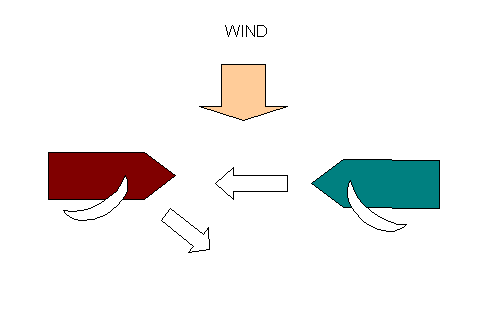
|
|
When
two sailboats approach each other on opposite tacks, the
sailboat on the starboard tack (i.e. wind coming across the
starboard rail) has the right of way. |
|
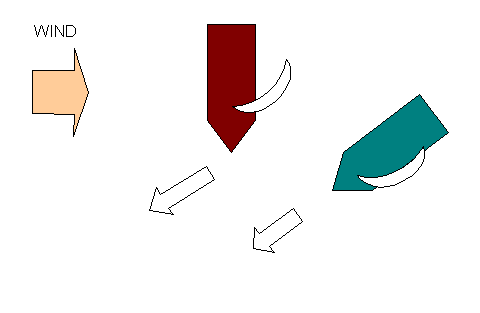
|
|
When two
sailboats approach each other on the same tack, the leeward boat
(i.e. boat farthest from the wind) has the right of way. |
|
|
|
Powerboat vs. Powerboat
|


|
|
When
two powerboats approach each other head on, they normally pass
to the right of one another (port to port); however, they can
pass starboard to starboard, but they should signal their
intentions (see
Signals &
Communications). |
|
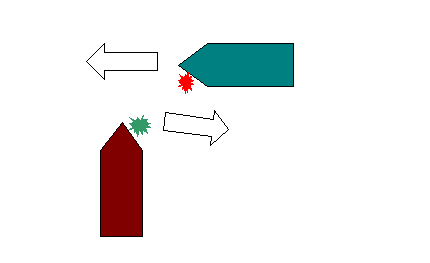
|
|
When two
powerboats approach each other at an angle, the boat to
starboard has the right of way. At night, the boat with
the right of way would see the green running light of the other
boat (indicating "go") and the other boat would see
the red running light of the boat with the right of way
(indicating "stop"). |
|
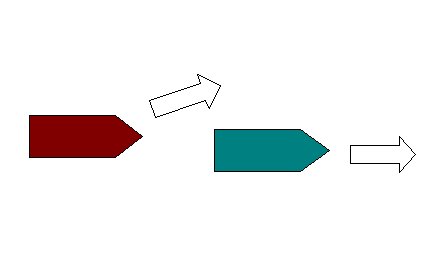
|
|
An
overtaken vessel--whether it be sail, power, or a
combination--has right of way over the vessel overtaking it. |
|
Prop Walk
|
Prop
walk is the tendency of the propeller to kick the stern of the boat in a
particular direction depending on which way the propeller spins.
Right hand propeller
turns clockwise.
Left hand propeller
turns counterclockwise.
Prop walk is more noticeable
in reverse and when first starting out in forward. |
Right
Hand Propeller
Forward -
kicks stern right
Reverse -
kicks stern left
Left Hand
Propeller
Forward -
kicks stern left
Reverse -
kicks stern right |
|
Warning:
When reversing a boat under power, pay careful attention never to let go
of the wheel or tiller. The backward motion of the boat will slam
the rudder hard over and can damage the rudder or steering mechanism. |
Turning under Power
|
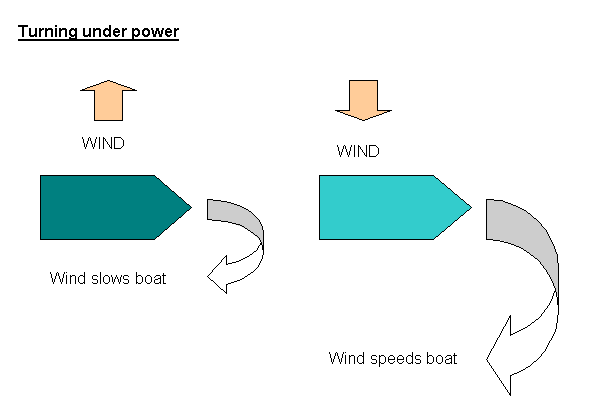
|
|
Tighter
turns can be made against the wind because the wind slows the
boat.
Turning with
the wind causes wider turns because the wind speeds the boat. |
|
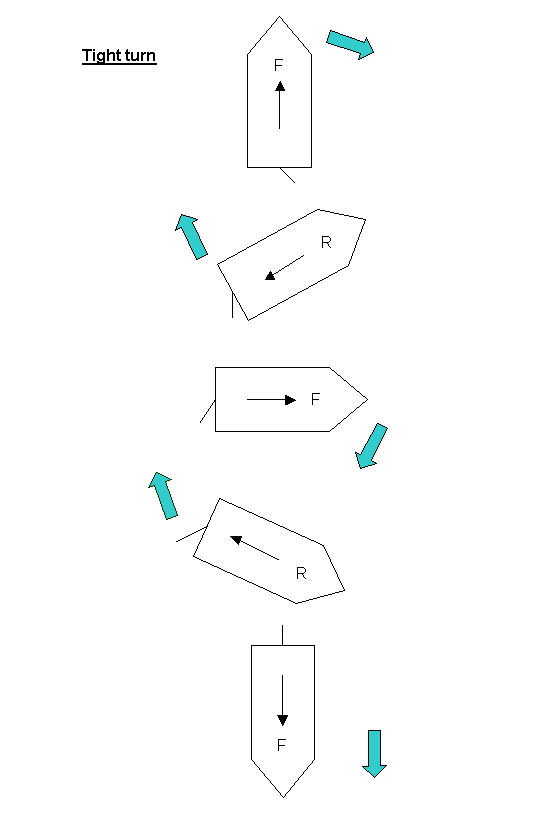
|
|
Backing
and Filling
(using
a right hand prop)
1. Start turn
in forward with the wheel hard over.
2. Shift into
reverse and use prop walk to turn stern (keep wheel hard over).
3. Shift into
forward.
4. Shift into
reverse.
5. Shift into
forward and center wheel. |
|
Leaving a Slip
|
Landing at an Upwind Dock
|
|
1.
Release spring lines.
2. Release bow and
stern lines.
3. Reverse
slowly. (Be aware of prop walk.)
4. Crew on the dock
walk bow and stern lines as they follow boat back. They also
carry fenders to protect the boat from the dock.
5. As the beam passes
the end of the dock, the crew step onto the boat. (The boat
should always be boarded at its widest point.)
6. Back out until
clear of the dock. (Drift in neutral once the boat is moving.)
7. Shift into forward
once clear of the slip.
8. Don't turn helm
until the boat is moving forward. (Be aware of prop walk when first
starting out.) |
1.
Lower sails
2. Rig a dock line to
the beam of the boat so the boat can be pulled to the dock without
pulling the bow into the dock.
3. Approach the dock
and make a pass to survey it.
4. The crew sets
fenders and keeps a spare to position in an emergency.
5. Two members of the
crew ready themselves at the shrouds with dock lines in hand.
6. Approach the
dock. Shift into neutral 3 to 6 boat lengths away.
7. Steer to within 1
foot of the dock when 1 boat length away.
8. Shift into reverse
at low rpm.
9. The crew steps onto
the dock and stops the boat with the aft spring line.
10. Shift into
neutral, center the boat, and secure it with the bow, stern and spring
lines. |
Leaving and Returning to a Slip
|
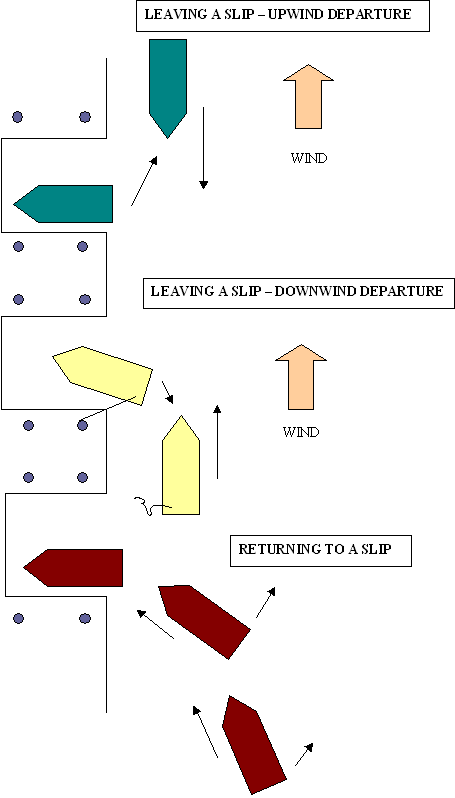
|
Leaving a Slip - Upwind
Departure
1.
Assess the wind and current before leaving the slip. Wind and
current will have the greatest effect when the boat is broad side.
2.
Pull the boat to the side of the slip closest to the wind.
3.
Reverse out of the slip and then motor forward.
Leaving a Slip - Downwind
Departure
1.
Assess the wind and current before leaving the slip. Wind and
current will have the greatest effect when the boat is broad side.
2.
Pull the boat to the side of the slip closest to the wind.
3.
Use a stern spring line to help swing the stern of the boat upwind.
4.
Reverse out of the slip, and then motor forward.
Returning to a Slip
1.
Glide in neutral to feel the wind and current.
2.
When 1 1/2 slips away, point to the far corner of the slip, then turn into
the slip to swing the stern around. Repeat until you are positioned
properly to pull into the slip.
|
Leaving a Dock under Power
|
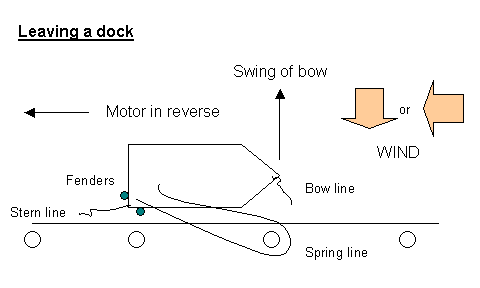
|
Upwind & Crosswind
Departures
1.
Double the stern spring line and cast off the bow and stern lines.
(Note: Always rig the spring line from the stern, NOT at midship.)
2.
Use the wind and reverse to turn the bow. (Note: The wind will
always turn the bow before the stern.)
3.
Release the spring line and motor forward.
Note:
Always snug the dinghy to the outside aft quarter. |
|
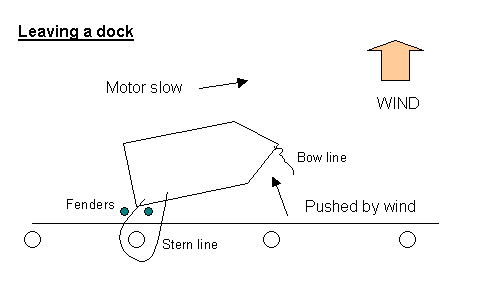
|
Crosswind
Departure
1. Double the
stern line and cast off the bow and spring lines.
2. Use the wind
to turn bow. (Note: The wind will always turn the bow before
the stern.) You can also throttle in reverse to turn the bow away from
the dock if the wind is not sufficient to turn it.
3. Release the
stern line and motor forward.
Note: Always
snug the dinghy to the outside aft quarter. |
|
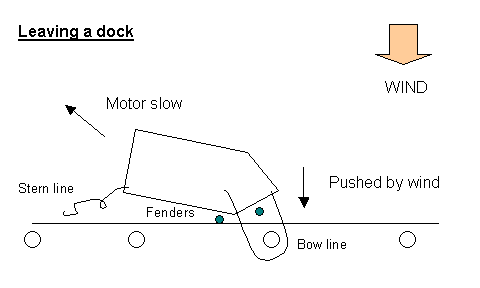
|
Crosswind
Departure
1. Double the
bow line and cast off the stern and spring lines.
2.
Use wind to turn the bow. (Note: The wind will always
turn the bow before the stern.)
3.
Release the bow line and reverse slowly away from the dock.
Note:
Always snug the dinghy to the outside aft quarter. |
|
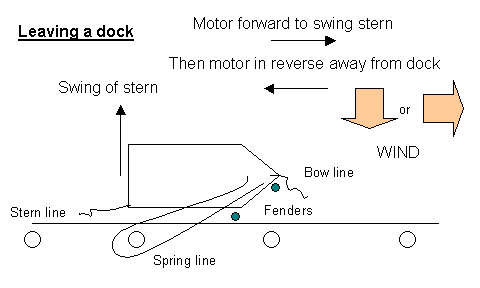
|
Downwind
& Crosswind Departures
1. Double the
bow spring line and cast off the bow and stern lines. (Note:
Always rig the spring line from the bow, NOT at amidships.)
2. Throttle
forward to turn the stern away from the dock.
3. Shift into
reverse and back away from the dock as you release the spring line.
Note:
Always snug the dinghy to the outside aft quarter. |
Docking under Power
|
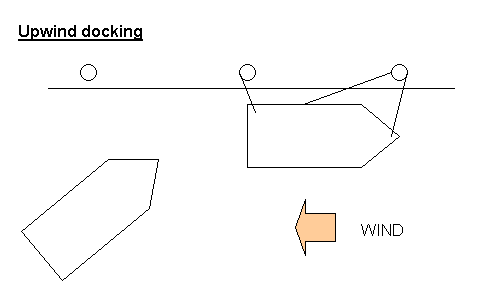
|
Upwind Docking
1.
Approach at a 45 degree angle.
2.
Make a smooth turn into the wind.
3.
Reverse engine.
4.
Secure fore midship spring line.
5.
Secure bow and stern lines.
Note:
Always snug the dinghy to the outside aft quarter before approaching the
dock. |
|
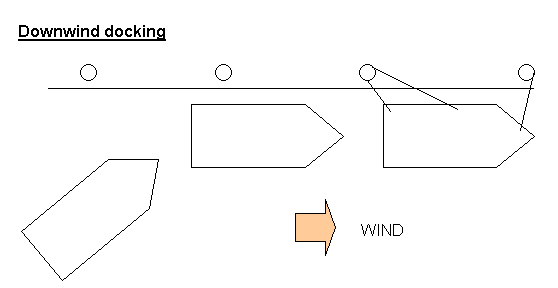
|
Downwind
Docking
1. Approach at a
45 degree angle.
2. Put engine in
neutral and turn slowly downwind, parallel to the dock.
3. Shift into
reverse to stop the boat.
4. Secure aft
midship spring line.
5. Secure bow
and stern lines.
Note: Always
snug the dinghy to the outside aft quarter before approaching the dock. |
|
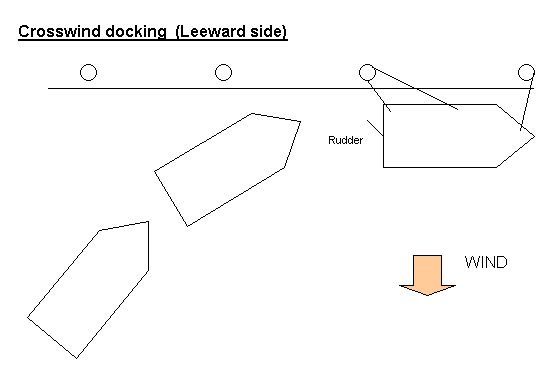
|
Crosswind
Docking
1. At low speed,
turn boat into the wind until 1/2 boat lengths from the dock.
2.
Make a tight turn to bring the boat parallel to the dock.
3.
Reverse the engine to stop.
4.
Secure the aft mid-ship spring line.
5.
Shift into forward and turn the wheel to hold the boat against the dock.
6.
Secure the bow and stern lines.
Note:
Always snug the dinghy to the outside aft quarter before approaching the
dock. |
|
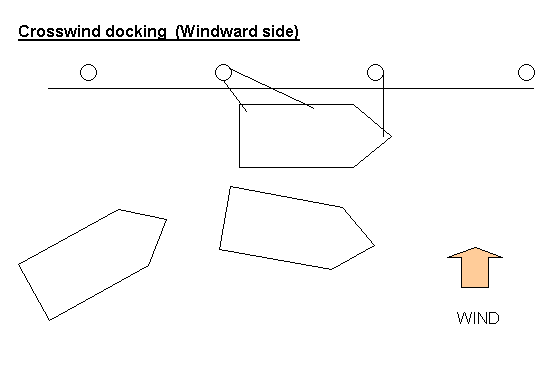
|
Crosswind
Docking
1. Approach at a
45 degree angle.
2. When the boat
is 1/2 boat length away, turn the boat parallel to the dock but with the
bow cocked toward the wind.
3. Reverse the
engine to stop the boat as it drifts to the dock.
4. Secure the
aft midship spring.
5. Secure the
bow and stern lines.
Note:
Always snug the dinghy to the outside aft quarter before approaching the
dock. |
Heaving-to
|
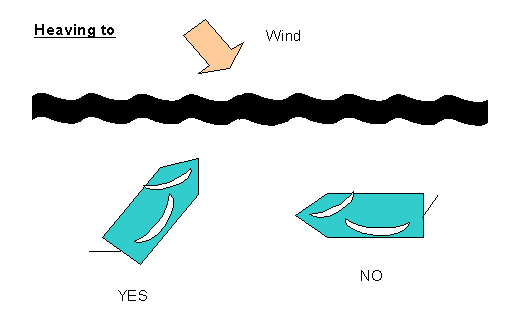
Always
heave-to on a tack that keeps the bow closest to oncoming waves.
Otherwise the waves will strike the beam of the boat making it more
difficult to remain hove-to. It could also put the boat in jeopardy
of being swamped in heavy weather.
|
If
the bow falls off:
1. Reduce sail
forward
2. Add sail aft.
3. Increase lee
helm. |
If
the bow heads up:
1. Add sail
forward.
2. Reduce sail aft.
3. Increase
windward helm. |
|
|
Every
sailor should know how to heave-to if just for safety's sake. It
can be used to ride out a storm, effect repairs, or just to stop
and have lunch.
When hove-to, the boat
lay across the wind and makes no forward progress; however, it will
slide sideways downwind, the progress and speed dependent on the size
and weight of the boat.
Heave-to by tacking
through the wind without releasing the jib. With the jib sail
backwinded, the tiller/wheel is then brought over hard in the opposite
direction and made fast.
The effect is that the
wind on the backwinded jib tries to turn the bow in one direction while
the rudder tries to turn the boat in the opposite direction. Both
forces cancel each other out, and the boat makes no forward progress.
|
Running Aground
|
Every
sailor will, at one time or another, run aground. It is
inevitable. The best thing you can do is to be on your toes to
avoid it. But if you should run aground, there are some things you
can do to help free yourself.
"Only two
sailors, in my experience, never ran aground. One never left port,
and the other was an atrocious liar.
- Don Bamford |
How
to un-ground a boat
1. Ease the
sheets.
2. Jibe
immediately.
3. Motor in
reverse.
4. Shift weight
to the bow or to one side.
5. Heel the boat
(by attaching weight to the boom).
6. Kedge off
with an anchor.
7. Accept a tow. |
Sail Trim
|
Line Selection
|
|
Bottom
telltale flutters up while mid and top telltale flow back:
- move car astern
Top telltale flutters
up:
- move car forward
Car is usually back
when beating upwind and forward when running downwind.
Most people over-trim
downwind and under-trim upwind.
When moving downwind,
remember the saying, "When in doubt, let it out." |
Nylon
- used for anchor and
mooring lines
Dacron
- used for sheets,
halyards & running rigging
Polyethylene
- used for ski ropes
& dinghy painter
Polypropylene
- used for ski ropes
Cotton
- used for flag
halyards & lanyards |
|
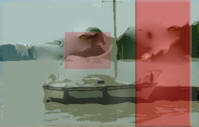



![]()